Evidence Based Commentary: Breastfeeding
VerifiedAdded on 2023/04/19
|10
|1840
|371
AI Summary
This evidence-based commentary explores the benefits, challenges, and gaps in nutritional knowledge associated with breastfeeding. Learn about the impact of breastfeeding on infant development and maternal health, as well as the personal, social, and cultural challenges faced by breastfeeding mothers. Discover the importance of improving caregiver skills and disseminating nutritional knowledge among low-income breastfeeding women.
Contribute Materials
Your contribution can guide someone’s learning journey. Share your
documents today.
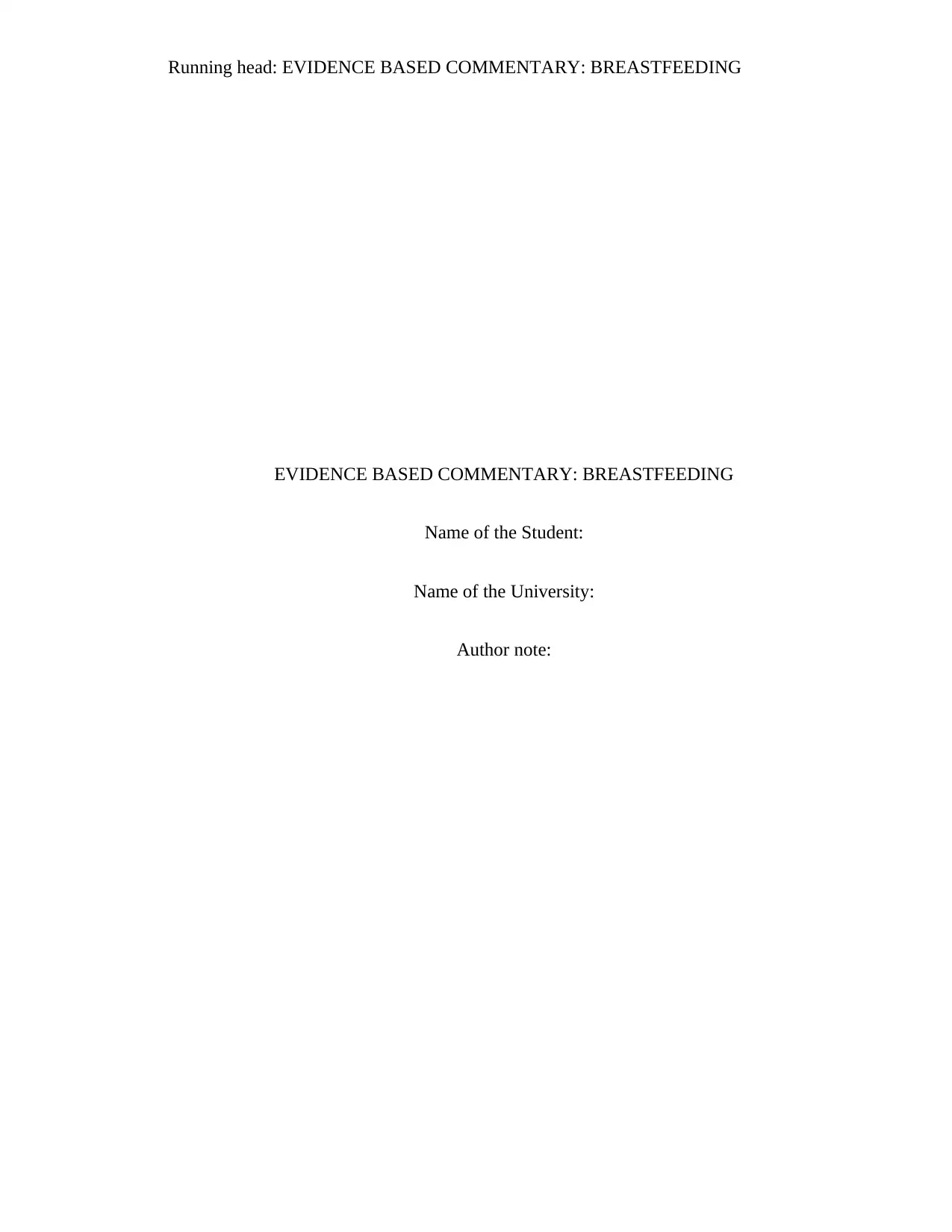
Running head: EVIDENCE BASED COMMENTARY: BREASTFEEDING
EVIDENCE BASED COMMENTARY: BREASTFEEDING
Name of the Student:
Name of the University:
Author note:
EVIDENCE BASED COMMENTARY: BREASTFEEDING
Name of the Student:
Name of the University:
Author note:
Secure Best Marks with AI Grader
Need help grading? Try our AI Grader for instant feedback on your assignments.

1EVIDENCE BASED COMMENTARY: BREASTFEEDING
Executive Summary
Breastfeeding is considered essential for the growth and development of an infant as well as for
the health of the mother. The following commentary focuses on the various benefits, challenges
and gaps in nutritional knowledge associated with breastfeeding. Breastfeeding has been
associated with improved cognitive, sensory, immunity and anthropometric in the baby, along
with resulting in reductions in risks of cancers in the concerned mother. However, considering
the prevalent gaps in knowledge as well societal stereotypes, future improvements must aim at
improving the skills of caregivers along with dissemination of nutritional knowledge and dietary
strategies among breastfeeding women residing in low income groups.
Executive Summary
Breastfeeding is considered essential for the growth and development of an infant as well as for
the health of the mother. The following commentary focuses on the various benefits, challenges
and gaps in nutritional knowledge associated with breastfeeding. Breastfeeding has been
associated with improved cognitive, sensory, immunity and anthropometric in the baby, along
with resulting in reductions in risks of cancers in the concerned mother. However, considering
the prevalent gaps in knowledge as well societal stereotypes, future improvements must aim at
improving the skills of caregivers along with dissemination of nutritional knowledge and dietary
strategies among breastfeeding women residing in low income groups.
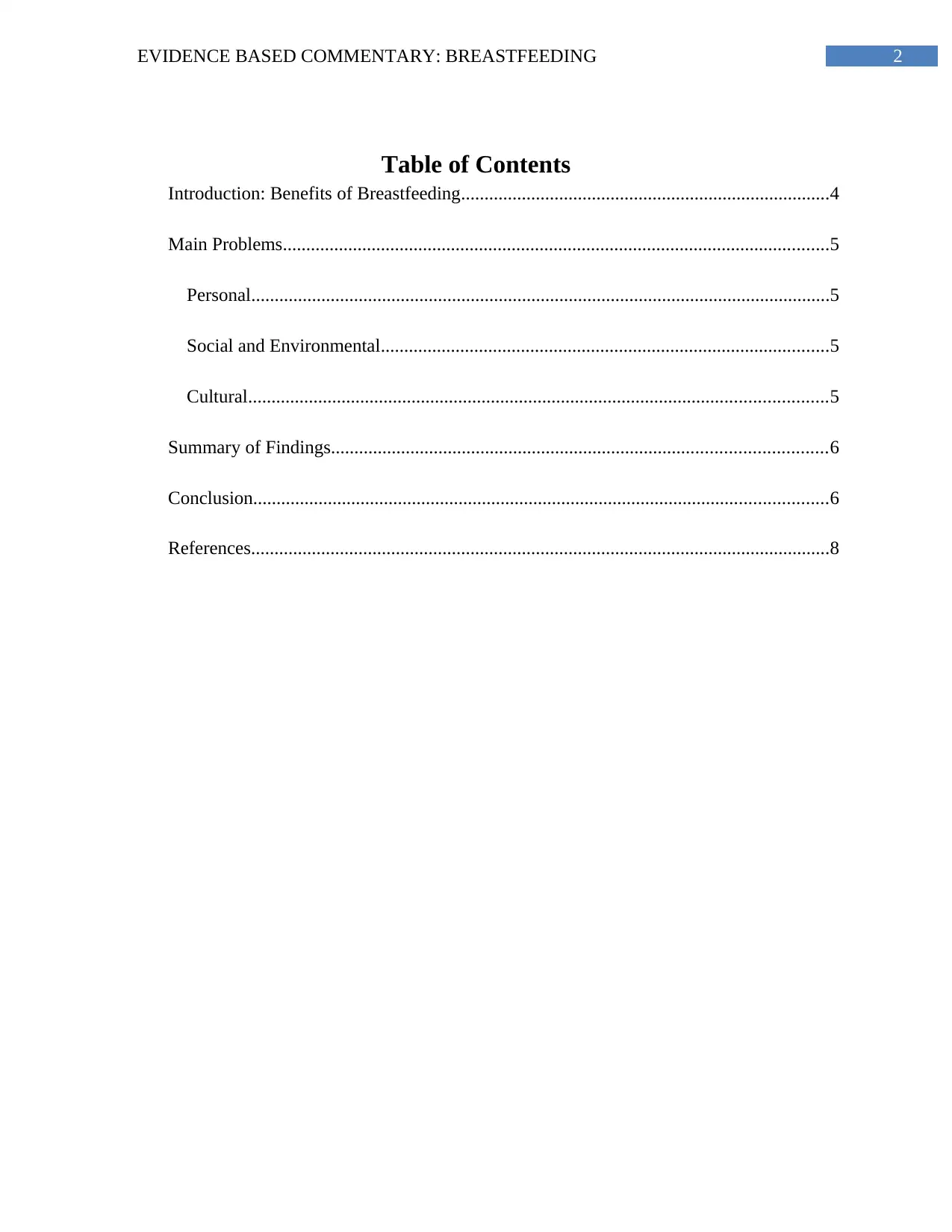
2EVIDENCE BASED COMMENTARY: BREASTFEEDING
Table of Contents
Introduction: Benefits of Breastfeeding...............................................................................4
Main Problems.....................................................................................................................5
Personal............................................................................................................................5
Social and Environmental................................................................................................5
Cultural............................................................................................................................5
Summary of Findings..........................................................................................................6
Conclusion...........................................................................................................................6
References............................................................................................................................8
Table of Contents
Introduction: Benefits of Breastfeeding...............................................................................4
Main Problems.....................................................................................................................5
Personal............................................................................................................................5
Social and Environmental................................................................................................5
Cultural............................................................................................................................5
Summary of Findings..........................................................................................................6
Conclusion...........................................................................................................................6
References............................................................................................................................8
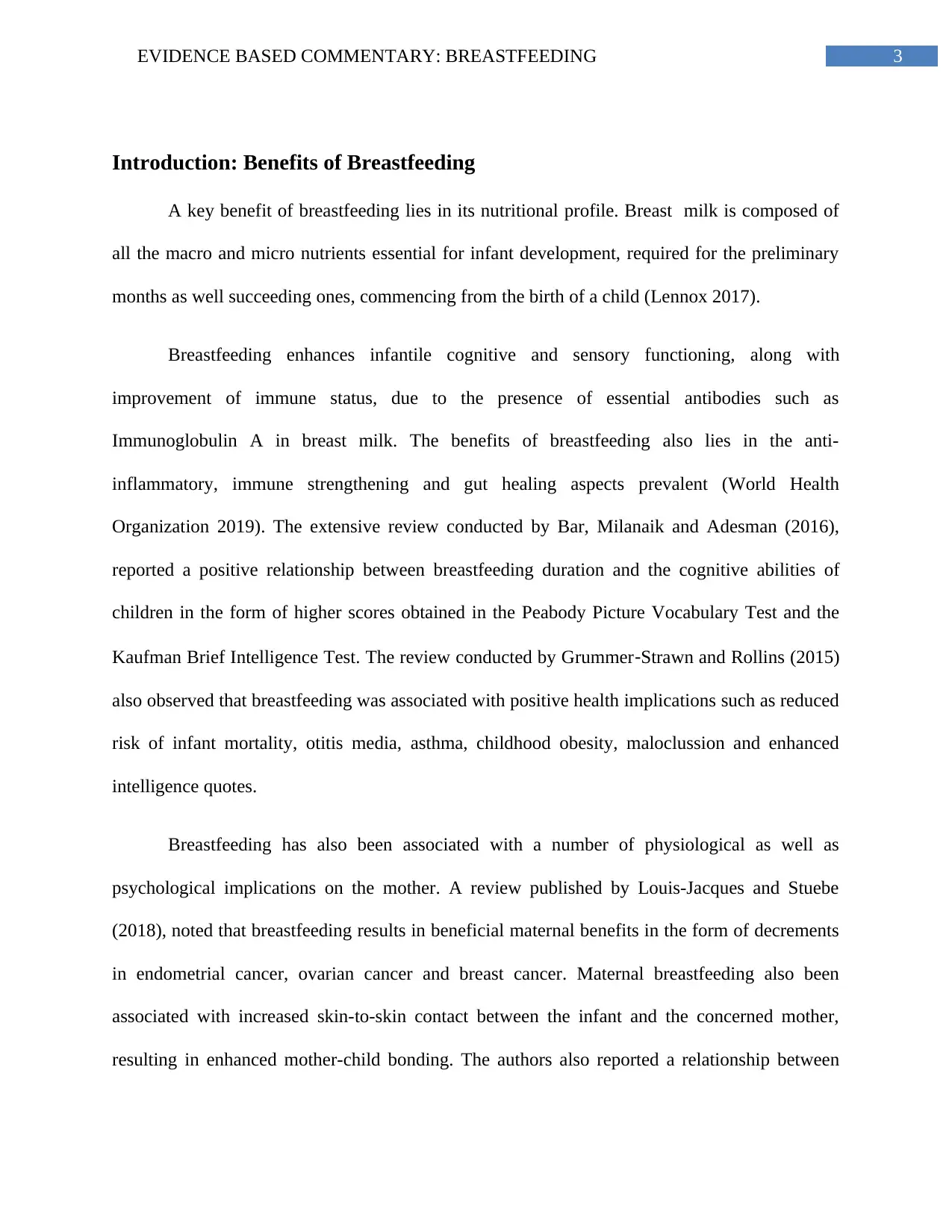
3EVIDENCE BASED COMMENTARY: BREASTFEEDING
Introduction: Benefits of Breastfeeding
A key benefit of breastfeeding lies in its nutritional profile. Breast milk is composed of
all the macro and micro nutrients essential for infant development, required for the preliminary
months as well succeeding ones, commencing from the birth of a child (Lennox 2017).
Breastfeeding enhances infantile cognitive and sensory functioning, along with
improvement of immune status, due to the presence of essential antibodies such as
Immunoglobulin A in breast milk. The benefits of breastfeeding also lies in the anti-
inflammatory, immune strengthening and gut healing aspects prevalent (World Health
Organization 2019). The extensive review conducted by Bar, Milanaik and Adesman (2016),
reported a positive relationship between breastfeeding duration and the cognitive abilities of
children in the form of higher scores obtained in the Peabody Picture Vocabulary Test and the
Kaufman Brief Intelligence Test. The review conducted by Grummer‐Strawn and Rollins (2015)
also observed that breastfeeding was associated with positive health implications such as reduced
risk of infant mortality, otitis media, asthma, childhood obesity, maloclussion and enhanced
intelligence quotes.
Breastfeeding has also been associated with a number of physiological as well as
psychological implications on the mother. A review published by Louis-Jacques and Stuebe
(2018), noted that breastfeeding results in beneficial maternal benefits in the form of decrements
in endometrial cancer, ovarian cancer and breast cancer. Maternal breastfeeding also been
associated with increased skin-to-skin contact between the infant and the concerned mother,
resulting in enhanced mother-child bonding. The authors also reported a relationship between
Introduction: Benefits of Breastfeeding
A key benefit of breastfeeding lies in its nutritional profile. Breast milk is composed of
all the macro and micro nutrients essential for infant development, required for the preliminary
months as well succeeding ones, commencing from the birth of a child (Lennox 2017).
Breastfeeding enhances infantile cognitive and sensory functioning, along with
improvement of immune status, due to the presence of essential antibodies such as
Immunoglobulin A in breast milk. The benefits of breastfeeding also lies in the anti-
inflammatory, immune strengthening and gut healing aspects prevalent (World Health
Organization 2019). The extensive review conducted by Bar, Milanaik and Adesman (2016),
reported a positive relationship between breastfeeding duration and the cognitive abilities of
children in the form of higher scores obtained in the Peabody Picture Vocabulary Test and the
Kaufman Brief Intelligence Test. The review conducted by Grummer‐Strawn and Rollins (2015)
also observed that breastfeeding was associated with positive health implications such as reduced
risk of infant mortality, otitis media, asthma, childhood obesity, maloclussion and enhanced
intelligence quotes.
Breastfeeding has also been associated with a number of physiological as well as
psychological implications on the mother. A review published by Louis-Jacques and Stuebe
(2018), noted that breastfeeding results in beneficial maternal benefits in the form of decrements
in endometrial cancer, ovarian cancer and breast cancer. Maternal breastfeeding also been
associated with increased skin-to-skin contact between the infant and the concerned mother,
resulting in enhanced mother-child bonding. The authors also reported a relationship between
Secure Best Marks with AI Grader
Need help grading? Try our AI Grader for instant feedback on your assignments.
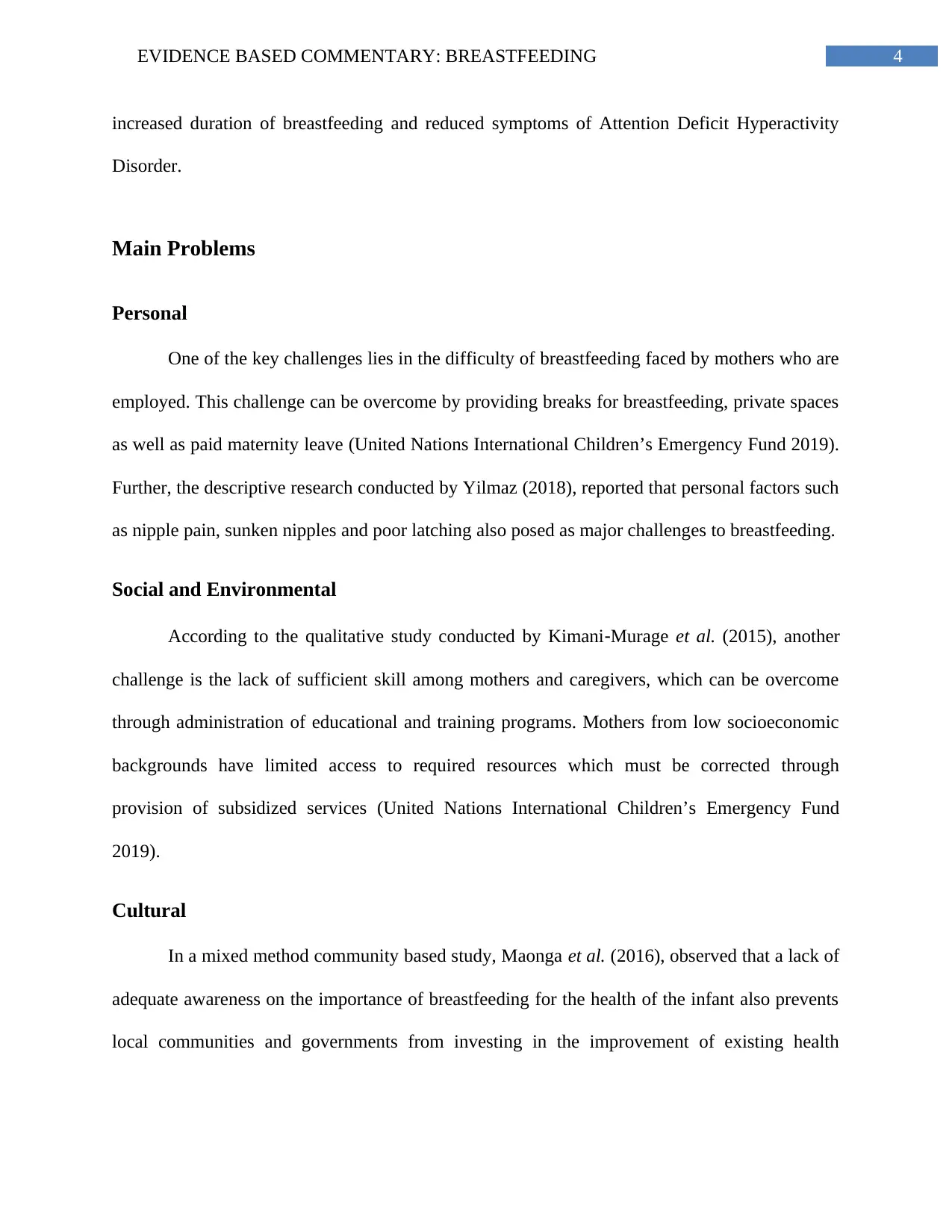
4EVIDENCE BASED COMMENTARY: BREASTFEEDING
increased duration of breastfeeding and reduced symptoms of Attention Deficit Hyperactivity
Disorder.
Main Problems
Personal
One of the key challenges lies in the difficulty of breastfeeding faced by mothers who are
employed. This challenge can be overcome by providing breaks for breastfeeding, private spaces
as well as paid maternity leave (United Nations International Children’s Emergency Fund 2019).
Further, the descriptive research conducted by Yilmaz (2018), reported that personal factors such
as nipple pain, sunken nipples and poor latching also posed as major challenges to breastfeeding.
Social and Environmental
According to the qualitative study conducted by Kimani‐Murage et al. (2015), another
challenge is the lack of sufficient skill among mothers and caregivers, which can be overcome
through administration of educational and training programs. Mothers from low socioeconomic
backgrounds have limited access to required resources which must be corrected through
provision of subsidized services (United Nations International Children’s Emergency Fund
2019).
Cultural
In a mixed method community based study, Maonga et al. (2016), observed that a lack of
adequate awareness on the importance of breastfeeding for the health of the infant also prevents
local communities and governments from investing in the improvement of existing health
increased duration of breastfeeding and reduced symptoms of Attention Deficit Hyperactivity
Disorder.
Main Problems
Personal
One of the key challenges lies in the difficulty of breastfeeding faced by mothers who are
employed. This challenge can be overcome by providing breaks for breastfeeding, private spaces
as well as paid maternity leave (United Nations International Children’s Emergency Fund 2019).
Further, the descriptive research conducted by Yilmaz (2018), reported that personal factors such
as nipple pain, sunken nipples and poor latching also posed as major challenges to breastfeeding.
Social and Environmental
According to the qualitative study conducted by Kimani‐Murage et al. (2015), another
challenge is the lack of sufficient skill among mothers and caregivers, which can be overcome
through administration of educational and training programs. Mothers from low socioeconomic
backgrounds have limited access to required resources which must be corrected through
provision of subsidized services (United Nations International Children’s Emergency Fund
2019).
Cultural
In a mixed method community based study, Maonga et al. (2016), observed that a lack of
adequate awareness on the importance of breastfeeding for the health of the infant also prevents
local communities and governments from investing in the improvement of existing health
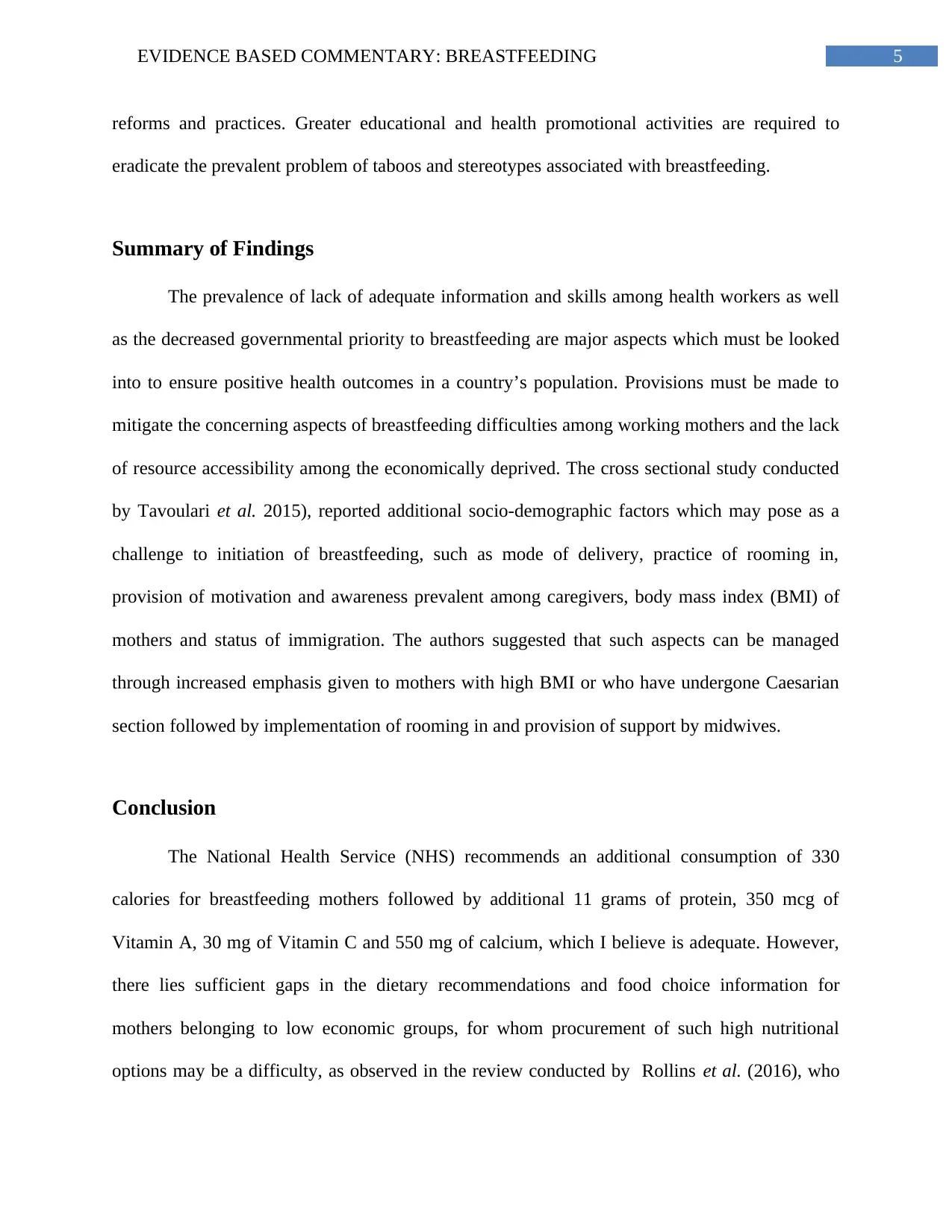
5EVIDENCE BASED COMMENTARY: BREASTFEEDING
reforms and practices. Greater educational and health promotional activities are required to
eradicate the prevalent problem of taboos and stereotypes associated with breastfeeding.
Summary of Findings
The prevalence of lack of adequate information and skills among health workers as well
as the decreased governmental priority to breastfeeding are major aspects which must be looked
into to ensure positive health outcomes in a country’s population. Provisions must be made to
mitigate the concerning aspects of breastfeeding difficulties among working mothers and the lack
of resource accessibility among the economically deprived. The cross sectional study conducted
by Tavoulari et al. 2015), reported additional socio-demographic factors which may pose as a
challenge to initiation of breastfeeding, such as mode of delivery, practice of rooming in,
provision of motivation and awareness prevalent among caregivers, body mass index (BMI) of
mothers and status of immigration. The authors suggested that such aspects can be managed
through increased emphasis given to mothers with high BMI or who have undergone Caesarian
section followed by implementation of rooming in and provision of support by midwives.
Conclusion
The National Health Service (NHS) recommends an additional consumption of 330
calories for breastfeeding mothers followed by additional 11 grams of protein, 350 mcg of
Vitamin A, 30 mg of Vitamin C and 550 mg of calcium, which I believe is adequate. However,
there lies sufficient gaps in the dietary recommendations and food choice information for
mothers belonging to low economic groups, for whom procurement of such high nutritional
options may be a difficulty, as observed in the review conducted by Rollins et al. (2016), who
reforms and practices. Greater educational and health promotional activities are required to
eradicate the prevalent problem of taboos and stereotypes associated with breastfeeding.
Summary of Findings
The prevalence of lack of adequate information and skills among health workers as well
as the decreased governmental priority to breastfeeding are major aspects which must be looked
into to ensure positive health outcomes in a country’s population. Provisions must be made to
mitigate the concerning aspects of breastfeeding difficulties among working mothers and the lack
of resource accessibility among the economically deprived. The cross sectional study conducted
by Tavoulari et al. 2015), reported additional socio-demographic factors which may pose as a
challenge to initiation of breastfeeding, such as mode of delivery, practice of rooming in,
provision of motivation and awareness prevalent among caregivers, body mass index (BMI) of
mothers and status of immigration. The authors suggested that such aspects can be managed
through increased emphasis given to mothers with high BMI or who have undergone Caesarian
section followed by implementation of rooming in and provision of support by midwives.
Conclusion
The National Health Service (NHS) recommends an additional consumption of 330
calories for breastfeeding mothers followed by additional 11 grams of protein, 350 mcg of
Vitamin A, 30 mg of Vitamin C and 550 mg of calcium, which I believe is adequate. However,
there lies sufficient gaps in the dietary recommendations and food choice information for
mothers belonging to low economic groups, for whom procurement of such high nutritional
options may be a difficulty, as observed in the review conducted by Rollins et al. (2016), who
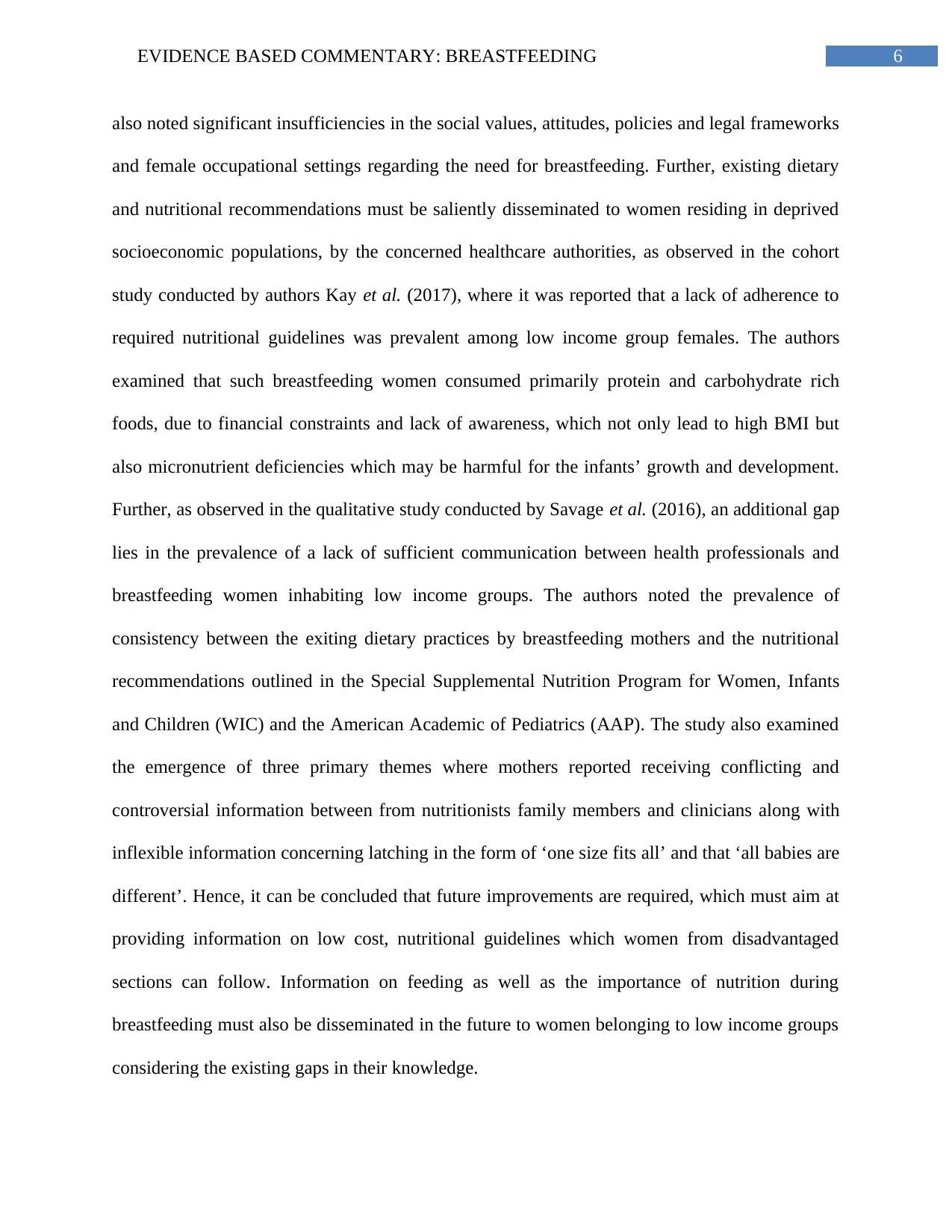
6EVIDENCE BASED COMMENTARY: BREASTFEEDING
also noted significant insufficiencies in the social values, attitudes, policies and legal frameworks
and female occupational settings regarding the need for breastfeeding. Further, existing dietary
and nutritional recommendations must be saliently disseminated to women residing in deprived
socioeconomic populations, by the concerned healthcare authorities, as observed in the cohort
study conducted by authors Kay et al. (2017), where it was reported that a lack of adherence to
required nutritional guidelines was prevalent among low income group females. The authors
examined that such breastfeeding women consumed primarily protein and carbohydrate rich
foods, due to financial constraints and lack of awareness, which not only lead to high BMI but
also micronutrient deficiencies which may be harmful for the infants’ growth and development.
Further, as observed in the qualitative study conducted by Savage et al. (2016), an additional gap
lies in the prevalence of a lack of sufficient communication between health professionals and
breastfeeding women inhabiting low income groups. The authors noted the prevalence of
consistency between the exiting dietary practices by breastfeeding mothers and the nutritional
recommendations outlined in the Special Supplemental Nutrition Program for Women, Infants
and Children (WIC) and the American Academic of Pediatrics (AAP). The study also examined
the emergence of three primary themes where mothers reported receiving conflicting and
controversial information between from nutritionists family members and clinicians along with
inflexible information concerning latching in the form of ‘one size fits all’ and that ‘all babies are
different’. Hence, it can be concluded that future improvements are required, which must aim at
providing information on low cost, nutritional guidelines which women from disadvantaged
sections can follow. Information on feeding as well as the importance of nutrition during
breastfeeding must also be disseminated in the future to women belonging to low income groups
considering the existing gaps in their knowledge.
also noted significant insufficiencies in the social values, attitudes, policies and legal frameworks
and female occupational settings regarding the need for breastfeeding. Further, existing dietary
and nutritional recommendations must be saliently disseminated to women residing in deprived
socioeconomic populations, by the concerned healthcare authorities, as observed in the cohort
study conducted by authors Kay et al. (2017), where it was reported that a lack of adherence to
required nutritional guidelines was prevalent among low income group females. The authors
examined that such breastfeeding women consumed primarily protein and carbohydrate rich
foods, due to financial constraints and lack of awareness, which not only lead to high BMI but
also micronutrient deficiencies which may be harmful for the infants’ growth and development.
Further, as observed in the qualitative study conducted by Savage et al. (2016), an additional gap
lies in the prevalence of a lack of sufficient communication between health professionals and
breastfeeding women inhabiting low income groups. The authors noted the prevalence of
consistency between the exiting dietary practices by breastfeeding mothers and the nutritional
recommendations outlined in the Special Supplemental Nutrition Program for Women, Infants
and Children (WIC) and the American Academic of Pediatrics (AAP). The study also examined
the emergence of three primary themes where mothers reported receiving conflicting and
controversial information between from nutritionists family members and clinicians along with
inflexible information concerning latching in the form of ‘one size fits all’ and that ‘all babies are
different’. Hence, it can be concluded that future improvements are required, which must aim at
providing information on low cost, nutritional guidelines which women from disadvantaged
sections can follow. Information on feeding as well as the importance of nutrition during
breastfeeding must also be disseminated in the future to women belonging to low income groups
considering the existing gaps in their knowledge.
Paraphrase This Document
Need a fresh take? Get an instant paraphrase of this document with our AI Paraphraser

7EVIDENCE BASED COMMENTARY: BREASTFEEDING
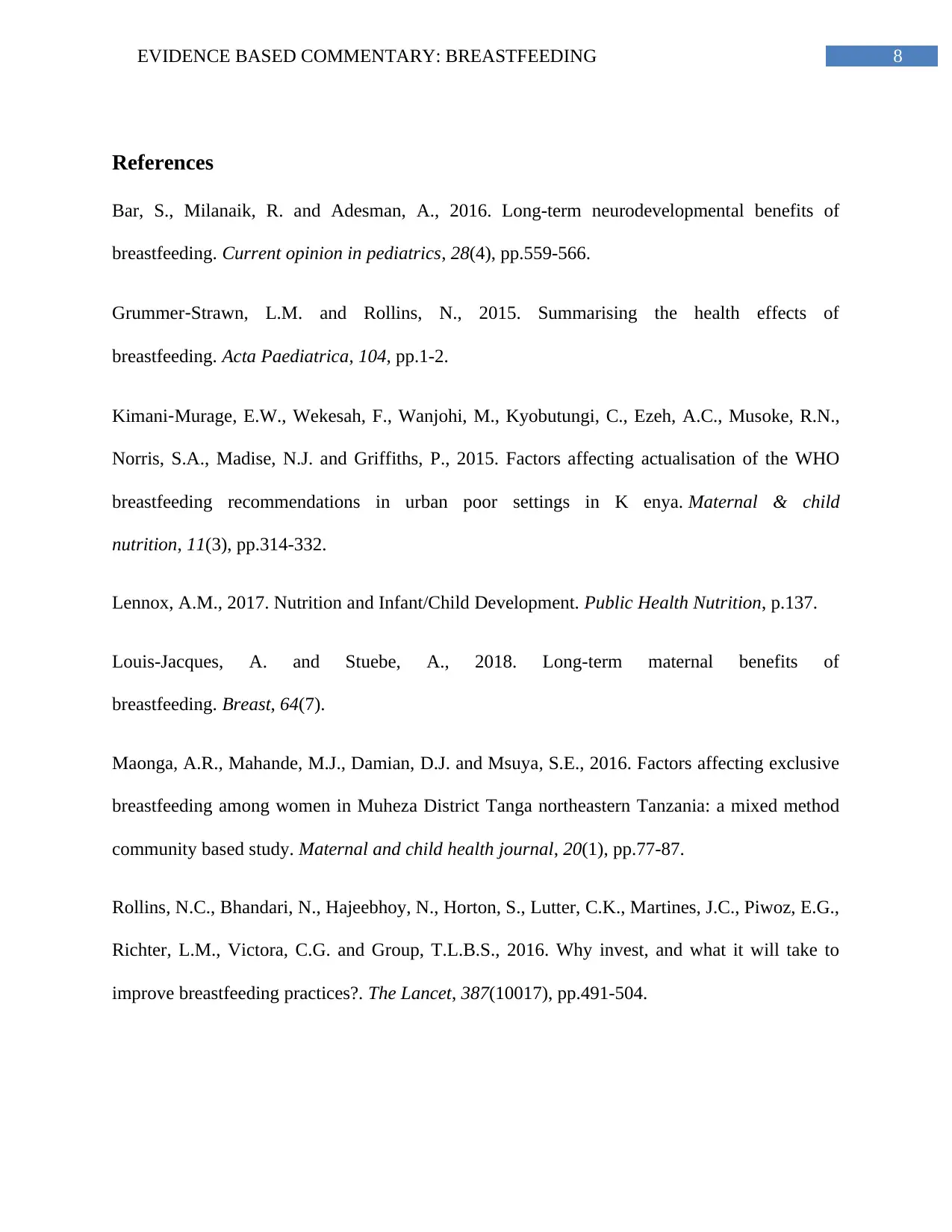
8EVIDENCE BASED COMMENTARY: BREASTFEEDING
References
Bar, S., Milanaik, R. and Adesman, A., 2016. Long-term neurodevelopmental benefits of
breastfeeding. Current opinion in pediatrics, 28(4), pp.559-566.
Grummer‐Strawn, L.M. and Rollins, N., 2015. Summarising the health effects of
breastfeeding. Acta Paediatrica, 104, pp.1-2.
Kimani‐Murage, E.W., Wekesah, F., Wanjohi, M., Kyobutungi, C., Ezeh, A.C., Musoke, R.N.,
Norris, S.A., Madise, N.J. and Griffiths, P., 2015. Factors affecting actualisation of the WHO
breastfeeding recommendations in urban poor settings in K enya. Maternal & child
nutrition, 11(3), pp.314-332.
Lennox, A.M., 2017. Nutrition and Infant/Child Development. Public Health Nutrition, p.137.
Louis-Jacques, A. and Stuebe, A., 2018. Long-term maternal benefits of
breastfeeding. Breast, 64(7).
Maonga, A.R., Mahande, M.J., Damian, D.J. and Msuya, S.E., 2016. Factors affecting exclusive
breastfeeding among women in Muheza District Tanga northeastern Tanzania: a mixed method
community based study. Maternal and child health journal, 20(1), pp.77-87.
Rollins, N.C., Bhandari, N., Hajeebhoy, N., Horton, S., Lutter, C.K., Martines, J.C., Piwoz, E.G.,
Richter, L.M., Victora, C.G. and Group, T.L.B.S., 2016. Why invest, and what it will take to
improve breastfeeding practices?. The Lancet, 387(10017), pp.491-504.
References
Bar, S., Milanaik, R. and Adesman, A., 2016. Long-term neurodevelopmental benefits of
breastfeeding. Current opinion in pediatrics, 28(4), pp.559-566.
Grummer‐Strawn, L.M. and Rollins, N., 2015. Summarising the health effects of
breastfeeding. Acta Paediatrica, 104, pp.1-2.
Kimani‐Murage, E.W., Wekesah, F., Wanjohi, M., Kyobutungi, C., Ezeh, A.C., Musoke, R.N.,
Norris, S.A., Madise, N.J. and Griffiths, P., 2015. Factors affecting actualisation of the WHO
breastfeeding recommendations in urban poor settings in K enya. Maternal & child
nutrition, 11(3), pp.314-332.
Lennox, A.M., 2017. Nutrition and Infant/Child Development. Public Health Nutrition, p.137.
Louis-Jacques, A. and Stuebe, A., 2018. Long-term maternal benefits of
breastfeeding. Breast, 64(7).
Maonga, A.R., Mahande, M.J., Damian, D.J. and Msuya, S.E., 2016. Factors affecting exclusive
breastfeeding among women in Muheza District Tanga northeastern Tanzania: a mixed method
community based study. Maternal and child health journal, 20(1), pp.77-87.
Rollins, N.C., Bhandari, N., Hajeebhoy, N., Horton, S., Lutter, C.K., Martines, J.C., Piwoz, E.G.,
Richter, L.M., Victora, C.G. and Group, T.L.B.S., 2016. Why invest, and what it will take to
improve breastfeeding practices?. The Lancet, 387(10017), pp.491-504.
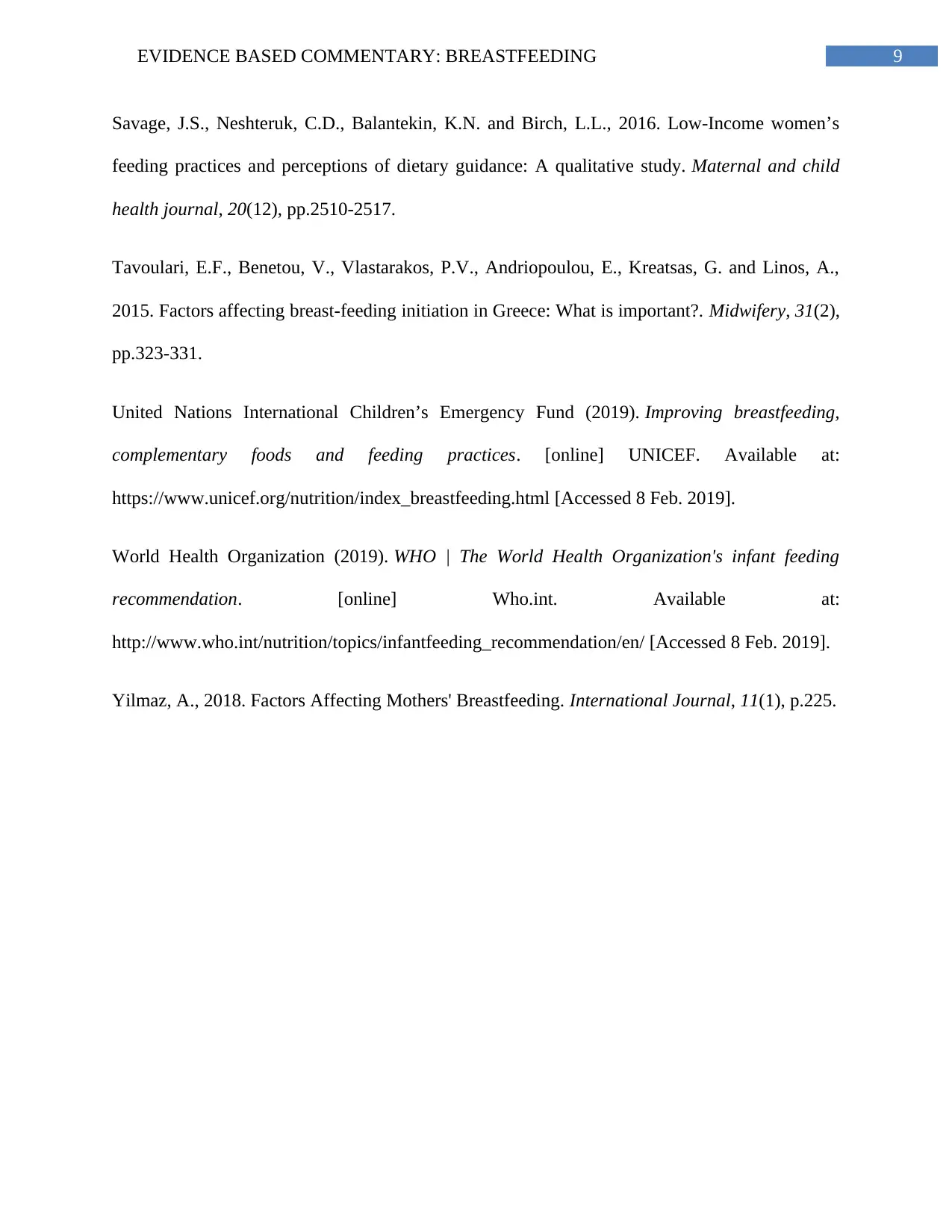
9EVIDENCE BASED COMMENTARY: BREASTFEEDING
Savage, J.S., Neshteruk, C.D., Balantekin, K.N. and Birch, L.L., 2016. Low-Income women’s
feeding practices and perceptions of dietary guidance: A qualitative study. Maternal and child
health journal, 20(12), pp.2510-2517.
Tavoulari, E.F., Benetou, V., Vlastarakos, P.V., Andriopoulou, E., Kreatsas, G. and Linos, A.,
2015. Factors affecting breast-feeding initiation in Greece: What is important?. Midwifery, 31(2),
pp.323-331.
United Nations International Children’s Emergency Fund (2019). Improving breastfeeding,
complementary foods and feeding practices. [online] UNICEF. Available at:
https://www.unicef.org/nutrition/index_breastfeeding.html [Accessed 8 Feb. 2019].
World Health Organization (2019). WHO | The World Health Organization's infant feeding
recommendation. [online] Who.int. Available at:
http://www.who.int/nutrition/topics/infantfeeding_recommendation/en/ [Accessed 8 Feb. 2019].
Yilmaz, A., 2018. Factors Affecting Mothers' Breastfeeding. International Journal, 11(1), p.225.
Savage, J.S., Neshteruk, C.D., Balantekin, K.N. and Birch, L.L., 2016. Low-Income women’s
feeding practices and perceptions of dietary guidance: A qualitative study. Maternal and child
health journal, 20(12), pp.2510-2517.
Tavoulari, E.F., Benetou, V., Vlastarakos, P.V., Andriopoulou, E., Kreatsas, G. and Linos, A.,
2015. Factors affecting breast-feeding initiation in Greece: What is important?. Midwifery, 31(2),
pp.323-331.
United Nations International Children’s Emergency Fund (2019). Improving breastfeeding,
complementary foods and feeding practices. [online] UNICEF. Available at:
https://www.unicef.org/nutrition/index_breastfeeding.html [Accessed 8 Feb. 2019].
World Health Organization (2019). WHO | The World Health Organization's infant feeding
recommendation. [online] Who.int. Available at:
http://www.who.int/nutrition/topics/infantfeeding_recommendation/en/ [Accessed 8 Feb. 2019].
Yilmaz, A., 2018. Factors Affecting Mothers' Breastfeeding. International Journal, 11(1), p.225.
1 out of 10
Related Documents
Your All-in-One AI-Powered Toolkit for Academic Success.
+13062052269
info@desklib.com
Available 24*7 on WhatsApp / Email
![[object Object]](/_next/static/media/star-bottom.7253800d.svg)
Unlock your academic potential
© 2024 | Zucol Services PVT LTD | All rights reserved.





